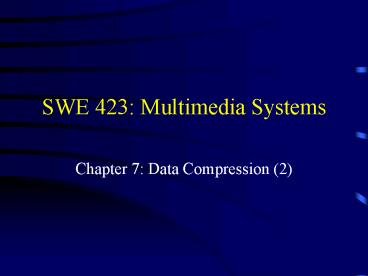SWE 423: Multimedia Systems PowerPoint PPT Presentation
1 / 22
Title: SWE 423: Multimedia Systems
1
SWE 423 Multimedia Systems
- Chapter 7 Data Compression (2)
2
Outline
- Entropy Encoding
- Arithmetic Coding
- Predictive Coding
- Lossless Predictive Coding
- Differential Coding
- Lossy Predictive Coding
- Differential Pulse Code Modulation Coding (DPCM)
- Delta Modulation (DM)
3
Entropy Encoding Arithmetic Coding
- Initial idea introduced in 1948 by Shannon
- Many researchers worked on this idea
- Modern arithmetic coding can be attributed to
Pasco (1976) and Rissanen and Langdon (1979) - Arithmetic coding treats the whole message as one
unit - In practice, the input data is usually broken up
into chunks to avoid error propagation
4
Entropy Encoding Arithmetic Coding
- A message is represented by a half-open interval
a,b), where a,b??. - General idea of encoding
- Map the message into an open interval a,b)
- Find a binary fractional number with minimum
length that belongs to the above interval. This
will be the encoded message - Initially, a,b) 0,1)
- When the message becomes longer, the length of
the interval shortens and the of bits needed to
represent the interval increases
5
Entropy Encoding Arithmetic Coding
- Coding Algorithm
- Algorithm ArithmeticCoding
- // Input symbol Input stream of the message
- terminator terminator symbol
- // Low and High all symbols ranges
- // Output binary fractional code of the message
- low 0 high 1 range 1
- do
- get (symbol)
- high low range High(symbol)
- low low range Low(symbol)
- range high low
- while (symbol ! terminator)
- return CodeWord(low,high)
6
Entropy Encoding Arithmetic Coding
- Binary code generation
- Algorithm CodeWord
- // Input low and high
- // Output binary fractional code
- code 0
- k 1
- while (value(code) lt low)
- assign 1 to the kth binary fraction bit
- if (value(code) gt high)
- replace the kth bit by 0
- k
7
Entropy Encoding Arithmetic Coding
- Example Assume S A,B,C,D,E,F,, where is
the terminator symbol. In addition, assume the
following probabilities for each character - Pr (A) 0.2
- Pr(B) 0.1
- Pr(C) 0.2
- Pr(D) 0.05
- Pr(E) 0.3
- Pr(F) 0.05
- Pr() 0.1
- Generate the fractional binary code of the
message CAEE
8
Entropy Encoding Arithmetic Coding
- It can be proven that ??log2 (1/? Pi)? is the
upper bound on the number of bits needed to
encode a message - In our case, the maximum is equal to 12.
- When the length of the message increases, the
range decreases and the upper bound value ...... - Generally, arithmetic coding outperforms Huffman
coding - Treats the whole message as one unit vs. an
integral number of bits to code each character in
Huffman coding - Redo the previous example CAEE using Huffman
coding and notice how many bits are required to
code this message.
9
Entropy Encoding Arithmetic Coding
- Decoding Algorithm
- Algorithm ArithmeticDecoding
- // Input code binary code
- // Low and High all symbols ranges
- // Output The decoded message
- value convert2decimal(code)
- Do
- find a symbol s so that
- Low(s) lt value lt High(s)
- output s
- low Low(s) high High(s) range high
low - value (value low) / range
- while s is not the terminator symbol
10
Entropy Encoding Arithmetic Coding
- Example
11
Predictive Coding
- Predictive coding simply means transmitting
differences - Predict the next sample as being equal to the
current sample - More complex prediction schemes can be used
- Instead of sending the current sample, send the
error involved in the previous assumption
12
Predictive Coding Why?
- The idea of forming differences is to make the
histogram of sample values more peaked. - In this case, what happens to the entropy?
- As a result, which is better to compress?
13
Predictive Coding Why?
14
Lossless Predictive Coding
- Formally, define the integer signal as the set of
values fn. Then, we predict values fn and
compute the error en as follows - when t 1, we get ...
- Usually, t is between 2 and 4 (in this case it is
called a linear predictor) - We might need to have a truncating or rounding
operation following the prediction computation
15
Lossless Predictive Coding
16
Lossless Predictive Coding Example
- Consider the following predictor
- Show how to code the following sequence
17
Lossless Predictive Coding
- Examples in the Image Compression Domain
- Differential Coding
- Lossless JPEG
18
Lossy Predictive Coding DPCM
- DPCM Differential Pulse Code Modulation
- Form the prediction f n
- Form an error en
- Quantize the error
19
Lossy Predictive Coding DPCM
- The distortion is the average squared error
- To illustrate the quality of a compression
scheme, diagrams of distortion vs. the number of
bit levels used are usually shown - Quantization used
- Uniform
- Lloyd-Max
- Does better than Uniform
20
Lossy Predictive Coding DPCM
21
Lossy Predictive Coding DPCM
- Example
- Show how to code the following sequence
22
Lossy Predictive Coding
- DM (Delta Modulation) is a simplified version of
DPCM that is used as a quick analog-to-digital
converter. - Note that the prediction simply involves a delay

